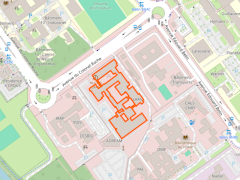Jean-Bernard Lasserre
I. Infinite-Dimensional linear systems
Existence of solutions. We consider cone-constrained linear systems in Banach spaces, whose positive cone is induced by a partial ordering. We have provided a very general Farkas-like Theorem of the alternative which avoids the restrictive closedness assumption on the image of the cone by the linear mapping.
This permits to derive necessary and sufficient conditions for existence of solutions to many problems such as Volterra or Fredholm equations (with non-compact operators), the probabilistic Poisson equation, etc ... In the case of "Banach lattices", the conditions have an even simpler form.
Computational Aspects. We consider a general linear programming problem in some Banach space and provide a (numerical) iterative scheme for computing the optimal value. We approximate the infinite-dimensional LP problem by a sequence of finite-dimensional LPs and prove (under weak assumptions) the asymptotic convergence of the corresponding sequence of optimal values to the optimal value of the original problem. We also prove that every accumulation point (in some appropriate weak topology) of the sequence of optimal solutions is an optimal solution of the original problem.
This also permits to derive a procedure for solving some linear equations, e.g. for computing the invariant probability of a Markov chain, for solving some linear partial diffential equations, etc ... To our knowledge, this is the first general computational scheme with such weak assumptions.
II. Homogeneous functions.
Legendre-Fenchel duality. We have shown that homogeneous functions play a special role with repect to the Legendre-Fenchel transform in "Convex Analysis". Indeed, the p-homgeneous functions are changed into q-homogeneous functions with 1/p+1/q=1. The same result is also true in other algebras for the corresponding transforms, e.g. the Bellman-Karush transform in the "min,+" algebra, the Laplace-transform in the "+,." algebra, the "min,max" transform in the "min,max" algebra.
A generalization of the Lowner-John ellipsoid. Given a compact set K (not necessarily convex) and "d" we consider the problem of computing a set "G" of the form {x: g(x)<= 1} that contains K, where "g" is a nonnegative and homogeneous polynomial of degree 2d, which is of minimum (Lebesgue) volume mong among all such sets. We show that it is a finite-dimensional convex problem with a unique solution, the higher-degree analogue of the celebrated Lowner-John ellipsoid in computational geometry. As for the latter we characterize the contacts points between G and K. In particular and quite surprisingly, the Lebesgue volume of G is a strictly convex function of the coefficient of "g". See
- Lasserre J.B. (2015) A generalization of Löwner-John's ellipsoid theorem Math. Program. 152, No 1 pp. 559--591.
- Lasserre J.B. (2015) Level sets and non Gaussian integrals of positively homogeneous functions Int. Game Theory Review 17 No 1,
An extension has been recently proposed in
- Best approximation of functions by log-polynomials by D. Alonso-Guttierez, B. Gonzales Merino and R. Villa in J. Functional Analysis 282(5), 109344 (2022).
III. Singular Perturbation of Linear Operators. We are interested in the singular perturbation of linear operators like the fundamental matrix of Markov chains, pseudo-inverse operators, Sylvester and Lyapunov equations, etc. The ultimate goal is to provide a simple procedure to get the Laurent series expansion in terms of the perturbation parameter. This Laurent series expansion provides insight on the bad behavior of the operator for small values of the parameter.
- Avrachenkov K. and Lasserre J.B. (2013) Analytic perturbation of generalized inversesPANIST Linear Algebra & Applications 438, pp. 1793--1813
See for instance the paper Laurent series based RBF-FD method to avoid ill-conditioning.
- P. Gonzalez-Rodriguez, V. Bayona and M. Moscoso. Engineering Analysis with Boundary Elements 52 (2015), pp. 24--31.
IV. Discrete optimization and counting We are interested in the problem of counting lattice points in a convex polytope with applications to discrete optimization. The idea is to use generating functions in the spirit of Brion and Vergne, Kantor, Sinai and Robins. We thus work in the space of "dual" variables associated with the nontrivial constraints that define the polytope; we then use the Z-transform (or generating function) of the function that counts the lattice points, considered as a function of the right-hand-side of the constraints. We then develop techniques to invert the Z-transform. We also use Brion and Vergne's periodic formula to derive a duality for integer programs, that parallels that of linear programming. In the same vein, we have also obtained a discrete Farkas lemma (for existence of a nonnegative integral solution to the linear system Ax=b) as well as an algebraic characterization of the integer hull of the covex rational polytope {Ax=b; x >=0}. All these contributions are reported in the book
- J.B. Lasserre (2009). Linear and Integer Programming vs Linear Integration and Counting, Springer-Verlag, New York. ISBN 978-0-387-09413-7
and also in particular a discrete version of Farkas Lemma in
- Lasserre J.B. (2004) A discrete Farkas lemma Discrete Optimization 1, pp. 67-75
- Lasserre J.B. and E.S. Zeron (2003) On counting integral points in a convex rational polytope, Math. Oper. Res. 28, pp. 853--870.
V. Inverse problems We are also interested in some Inverse Problems in Computational Geometry, Optimization, and Optimal Control, and show how they can be solved by the Moment-SOS Hierarchy. Namely:
- Reconstructing an unknown n-dimensional geometric object from the only knowledge of moments of a measure supported on this object. In particular we have shown how to recover the vertices of a polytope K from the sole knowledge of finitely many moments of the Lebesgue measure on K. Similarly, we can also recover the polynomial "g" that defines the boundary of the set G={x: g(x) <=1} from the sole knowledge of finitely many moments of the Lebesgue measure on G.
- Gravin N., Lasserre J.B., Pasechnik D. and Robins S. (2012) The Inverse Moment Problem for Convex Polytopes Discrete & Comp. Geom. 48, pp. 596--621
- Lasserre J.B. (2013) Recovering an homogeneous polynomials from moments of its levels set Discrete & Comput. Geom. 50, pp. 673--678
- Lasserre J.B., Putinar M. (2015) Algebraic-exponential Data Recovery from Moments Discrete & Comput. Geom. 54 pp. 993--1012.
- Super-Resolution in signal processing, i.e., reconstructing a sparse signal (a signed atomic measure) from a few moments.
- De Castro Y., Gamboa F., Henrion D., Lasserre J.B. (2017) Exact solutions to Super Resolution on semi-algebraic domains in higher dimensions, IEEE Trans. Info. Theory 63, pp. 621--630.
- Sparse interpolation (reconstructing a sparse polynomial from a few evaluations)
- Josz C., Lasserre J.B., Mourrain B. (2019) Sparse polynomial interpolation: sparse recovery, super resolution, or Prony? Advances Comp. Math. 45, pp. 1401--1437
- Inverse optimization: Given a feasible solution "y" and a criterion "f" to minimize, find a criterion "g" as close as possible to "f" and such that "y" is a global optimizer for this new criterion.
- Lasserre J.B. (2013) Inverse polynomial optimization Math. Oper. Res. 38, pp. 418--436
- Inverse Optimal Control: Given a systems dynamics and a database of (trained) trajectories, find a Lagrangian for which those trajectories are optimal. This problem was motivated by Humanoid Robotics where one goal is to understand human walk.
- Pauwels E., Henrion D., Lasserre J.B. (2016) Linear Conic Optimization for Inverse Optimal Control, SIAM J. Control & Optim. 54 pp. 1798--1825.votre contenu ici













